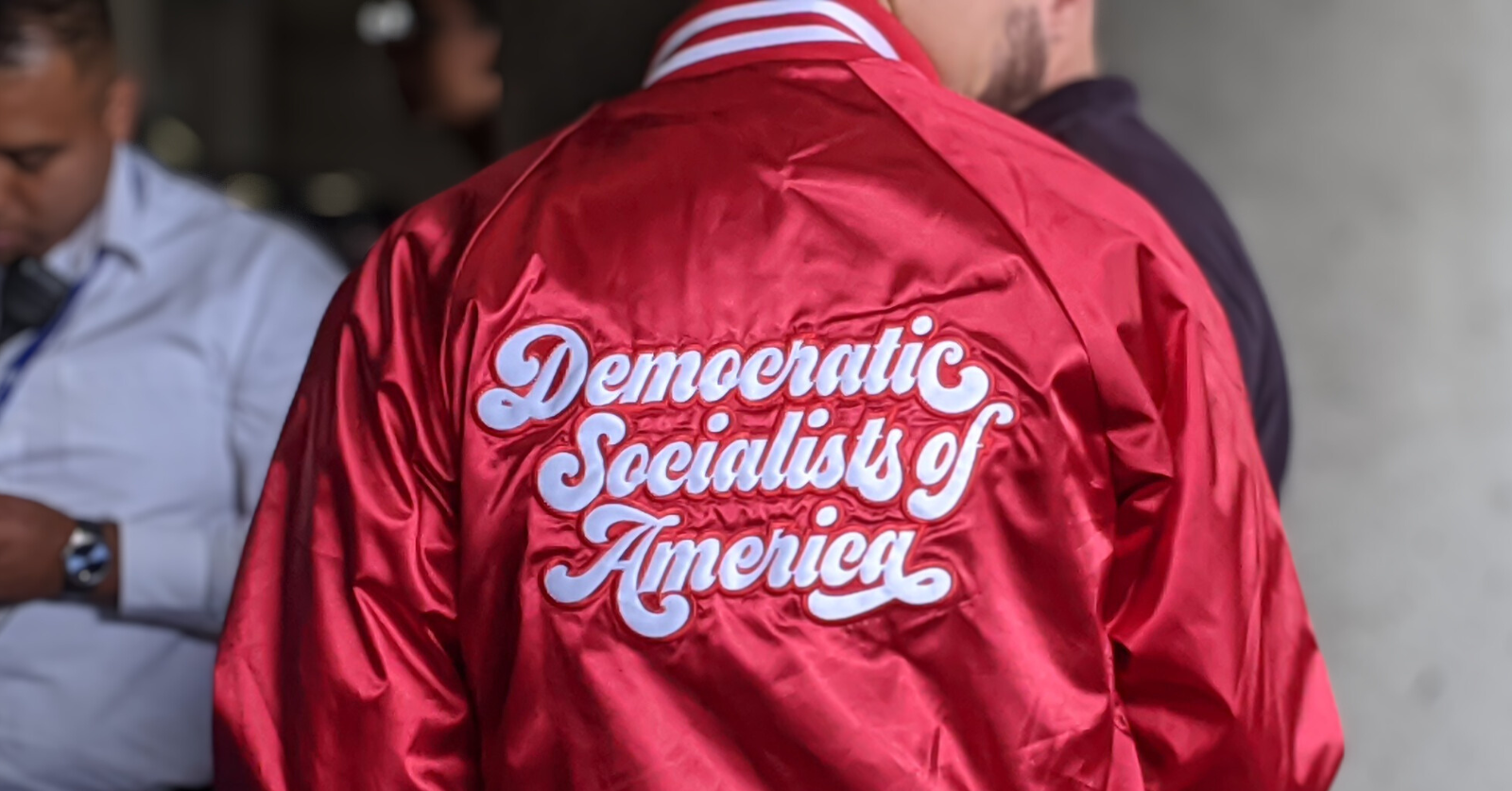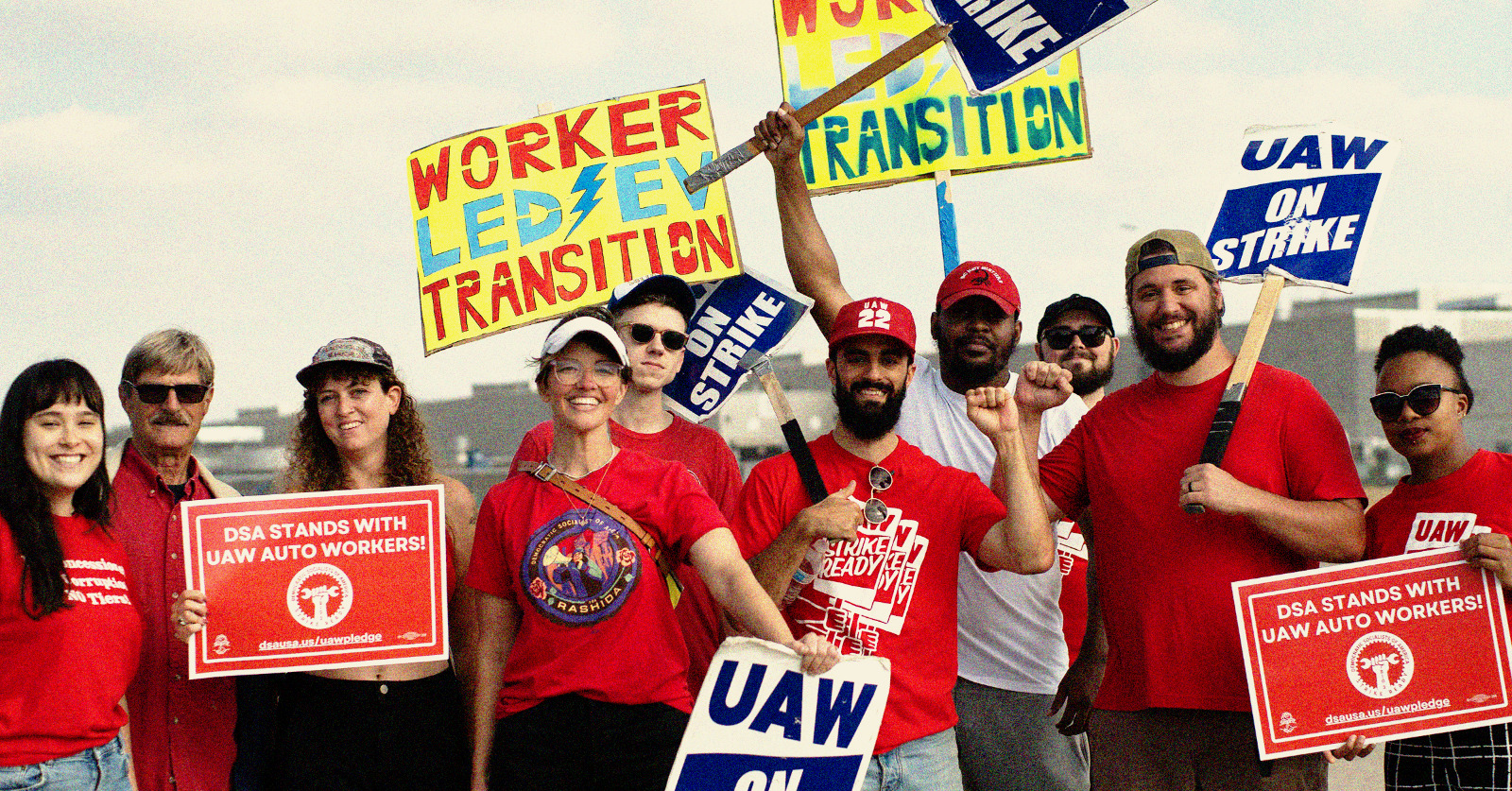Delegates heading home from the 2019 DSA National Convention on Monday, August 5, did so precisely 1,000 days after the 2016 presidential election upended American politics as we knew it. That election shook millions of people out of the belief that fighting for progressive change ought to be left in the hands of political experts.
Inspired by Bernie Sanders and mobilizations like Occupy Wall Street and Black Lives Matter, hundreds of thousands of people embraced the politics of democratic socialism. And in wave after wave, starting on Election Day 2016, many joined America’s small but resilient Democratic Socialists of America — an organization that had for decades helped keep the flame of left-wing politics burning (however dimly).
The 1,000-day period bookended by that election and the close of the 2019 DSA national convention is a first step in the unexpected but more than welcome resurgence of American socialism. This essay is an attempt to assess that period and figure out what comes next.
How Far We’ve Come
For those of us engaged in the lively day-to-day struggles of organizing, it is easy to gloss over DSA’s achievements. But taken together, they reflect the record of a functionally new organization firmly implanting itself in American politics. Despite enormous hurdles and no shortage of internal debate, DSA has proven that it can thrive in once virulently anti-socialist soil.
Though hardly comprehensive, the following overview — compiled from news articles and the organization’s publications, reports, and blogs — is a quick attempt at recording the new DSA’s activity and victories in the last 1,000 days.
Winter-Spring 2017
DSA chapters spring up across the country as the organization triples in size in only a few months. Major activity is focused on mobilizing for anti-Trump demonstrations — including for the Women’s March and the International Women’s Strike — and setting up the framework for new chapters. DSA’s National Electoral Committee (NEC) is launched to systematize our electoral work. Activists in East Bay in California and New York City begin canvassing for state single-payer bills. DSA mobilizes to support the national AT&T Mobility strike, and members across the country partake in reviving an age-old socialist tradition: May Day demonstrations.
Summer 2017
Core groups of organizers cohere to learn the ropes of democratic decision-making. In Los Angeles, DSA activists begin a pressure campaign to push ICE out of the city and rack up some important concessions from the city government. Across the country, DSA participates in anti-Trump contingents in pride parades. In New Orleans, DSA members launch a “brake lights clinic,” which inspires similar projects elsewhere. And DSA veterans come together to launch DSA’s Veterans Working Group to oppose U.S. imperialism.
In August, the national convention in Chicago turns over a new leaf in the organization’s history, as DSA adopts Medicare for All (M4A), electoral work, and labor organizing as its top priorities. The organization also adopts a more aggressively left-wing orientation by officially leaving the decaying Socialist International and endorsing the Boycott, Divestment, Sanctions movement in Palestine.
Fall 2017
First electoral pushes. Lee Carter wins a remarkable victory to Virginia’s State House, beating a Republican leader, and bringing DSA’s representation in state legislatures from three to four. (Kaniela Ing in Hawaii, Mike Connolly in Massachusetts, and Mike Sylvester in Maine were DSA members elected before 2016.) J.T. Scott and Tristan Rader win their elections to the Somerville Board of Aldermen and Lakewood City Council, respectively. DSA supports impressive city council runs by Khader El-Yateem and Jabari Brisport in New York City, Ginger Jentzen in Minneapolis, and Jon Grant in Seattle, though all four came up short.
DSA’s Medicare-for-All campaign launches. In Philadelphia, DSA launches its first Socialist Night School, a program subsequently adopted by many other chapters. In Providence, DSA members begin a campaign to socialize their state’s electrical company.
Winter 2018
In West Virginia, DSA teacher organizers are among the key leaders of a two-week long illegal strike. They win higher pay, prevent Republican attempts to cut benefits for the poor, and help kick off a national teacher strike wave. The National Political Committee (NPC) unanimously passes the National Electoral Strategy. A new Steering Committee is elected for the Democratic Socialist Labor Commission (DSLC) and the DSLC gets to work helping to ground DSA’s labor work. The M4A national campaign begins building local canvassing operations. In Austin, DSA M4A activists help push through a paid sick days law in their city council.
Spring 2018
The teacher strike wave comes to Arizona, Kentucky, Oklahoma, and elsewhere, and DSA is out in force to support the striking teachers. Workers in the University of California system also walk out, supported by DSA. Labor Notes holds its biennial conference in Chicago and hundreds of DSA activists attend as rank-and-file workers and guests to participate and help build it. DSA chapters raise significant money for the National Network of Abortion Funds and help build May Day contingents. And the DSA M4A campaign organizes the first of three major national weekends of action for Medicare for All.
Summer 2018
Major victory in New York City when Alexandria Ocasio-Cortez (AOC) — thanks in large part to an impressive mobilization on the part of NYC-DSA — wins the congressional primary. Kaniela Ing, Cynthia Nixon, and Jumaane Williams, also endorsed by DSA, lose their bids for one of Hawaii’s congressional seats and the New York governor and lieutenant governor’s offices, respectively. The DSLC and the Young Democratic Socialists of America (YDSA) publish “Why Socialists Should Become Teachers,” a case for why activists should get union teaching jobs and work to transform their unions. DSA labor activists in New York City begin their work building a rank-and-file organizing project. And in Philadelphia, DSA activists force the city council to pass a resolution endorsing Medicare for All.
Fall 2018
DSA-backed candidates rack up important wins in the midterm elections. AOC cruises to victory in her general election, joined in Congress by Rashida Tlaib from Detroit. Elizabeth Fielder, Summer Lee, and Sara Innamorato win races in Pennsylvania’s State House. Julia Salazar beats the Brooklyn machine to get elected to the New York State Senate. Amy Perruso wins a seat in the Hawaii State House of Representatives. Gabriel Acevero and Vaughn Stewart are elected to Maryland’s House of Delegates. Jade Bahe wins in Montana’s House of Representatives. Mike Connolly is reelected to the Massachusetts state legislature and Mike Sylvester to Maine’s. These victories bring DSA-endorsed members in the House from 0 to 2 and in state legislatures from 4 to 11 (including Lee Carter in Virginia who is not up for reelection in 2018) — a drop in the bucket out of the total 7,383 state legislative seats in the United States but an important beachhead for democratic socialist politics nonetheless.
Rachel Miller, Kara Gloe, and Franklin Bynum win elections to the Providence City Council, Moorhead School Board in North Dakota, and Harris County Criminal Court in Houston, respectively. DSA runs strong campaigns though comes up short in the fight to repeal anti-rent control laws in California and in races for seats in the California State Assembly, Pennsylvania’s State House, Arizona’s House of Representatives, Paterson City Council in New Jersey, and Montgomery County Council in Maryland, as well as a race for California lieutenant governor and San Diego County district attorney.
DSA mobilizes its members to support the national strike led by UNITE HERE at Marriott hotels. And the DSA Medicare-for-All campaign organizes the first of two national M4A speaking tours.
Winter 2019
The teachers strike wave continues, and DSA plays an important role in strike support in Denver, Los Angeles, and Oakland, as well as in the first ever charter-school strike in Chicago. In Philadelphia, DSA helps pass a new Fair Workweek ordinance. In California, DSA chapters begin to organize around bringing the state’s electric company under public ownership and control. DSA activists in Detroit launch a campaign to “Make Detroit the Engine of a Green New Deal” and successfully block the appointment of Blue Cross Blue Shield’s CEO to the new governor’s cabinet. The Medicare-for-All campaign pressures moderate Democrats to sign on as supporters of M4A. The National Office organizes regional pre-convention conferences across the country. DSA restarts its International Committee to build relationships with socialists and social movement activists across the world.
Spring 2019
DSA stuns the city of Chicago by electing six of its city council candidates — Daniel LaSpata, Jeanette Taylor, Byron Sigcho-Lopez, Carlos Ramirez-Rosa, Rossana Rodriguez-Sanchez, and Andre Vasquez. That brings Chicago’s socialist delegation in City Council up to 12% of the entire chamber, raising hopes of a “Red Chicago” in the future. Following up on the energy of the L.A. teachers strike supported by DSA, Jackie Goldberg wins her race for the L.A. Board of Education. DSA candidates for St. Louis’s Board of Aldermen, Kansas City Council, and Fairfax County Supervisor run impressive campaigns but lose. Tragically, after an impressive fight that DSA played a critical role in, Tiffany Cabán narrowly loses her race for Queens County District Attorney in NYC.
Grocery store workers at Stop and Shop go on strike across New England and DSA mobilizes to support them on the picket lines. DSA activists working at San Francisco’s Anchor Brewing help win a union there — a small but inspiring victory in the battle to expand the reach of the labor movement. After a national referendum in which 76% of members vote yes, DSA proudly endorses Bernie Sanders and launches its national Bernie campaign. In Austin, DSA’s M4A campaign forces Democrat Lloyd Doggett to finally support Medicare for All and wins a similar victory in Louisville where Democrat John Yarmuth is forced to do so as well. And DSA activists from across the northeast meet in Philadelphia for a socialist-feminist convergence.
Summer 2019
DSA activists in New York help win new rent regulations that bring serious relief to hundreds of thousands of tenants as part of a broad pro-tenant coalition. Grad students at the University of Chicago go on strike, supported by DSA. DSA labor activists in New York City release their report on their first year of successful work building rank-and-file groups in the city’s strategic industries.
One thousand delegates converge in Atlanta to review the progress of the last two years and lay plans for the future. Delegates elect a new National Political Committee that reflects the political diversity of the organization. DSA elected officials meet and lay plans for the future and socialist delegates from across the world participate in the activities. DSA adopts a Green New Deal campaign; recommits to the rank-and-file strategy, waging class-struggle electoral campaigns, and fighting for Medicare for All; and takes on a host of new issue-based fights.
New Questions
Compared to conventions in 2013 and 2015 (which I also attended) and even 2017, the 2019 convention was marked by a palpable sense of responsibility. In the past, DSA was truly on the margins of American political life with only a few hundred active members in the entire country. While the work we undertook to build DSA helped lay the foundation for what it has become, at the time conventions were staid affairs.
No one could say that of this year’s gathering, and the reason is fairly obvious: what we do actually matters now. After Bernie Sanders and Alexandria Ocasio-Cortez, DSA is by far the most important force for democratic socialist ideas in the country and is treated as such by the national media. Our choices and work are covered in national publications and local press alike. And for millions of people who now call themselves socialists or are thinking about becoming socialists, understanding what DSA says and does helps them understand the world and how to act. DSA is now an important beacon for working-class struggle.
What we do with that responsibility, and whether we can live up to it, is what we now have to determine. As I see it, four main questions have to be answered in the next two years.
First, we have to find the right balance between projecting confidence in our project and staying rooted in reality.
It would of course be easy to retreat from our new responsibilities under the guise of false modesty. To play down the contributions DSA has made to labor fights and electoral struggles. Such a course would be a major setback however. Building an open, proud, and militant socialist movement is an essential step towards winning a better world — and DSA today is far and away the biggest part of that movement. Celebrating and learning from our wins is necessary to raising our confidence and strength.
But we also have to avoid the trap of hubris. DSA is important, especially to the growth of socialist politics, but certainly not the most important factor in working-class struggle today. After three years of trial and error, we know far more than “some of the right questions” — which some on the Left prior to 2016 used to assert was all we could claim to know. But we are far from having a full program or plan for social transformation.
Second, we have to develop a clearer sense of what we’re building towards.
As many have noted, if there’s one thing the 2019 national convention resolved it was whether or not DSA should be a strong national organization or a federation of autonomous chapters. The plan to replace the national leadership with a 400-person “Assembly of the Locals” was roundly rejected, as were proposals to gut the national organization’s finances. In fact most of the most popular resolutions were ones that proposed new national campaigns with support from national paid staff. As the Collective Power Network put it, “a strong mandate from the membership around mass work and a strong national” was won at the convention.
But it’s the question of what comes next in DSA’s organizational evolution that continues to be unresolved. The Class Struggle Elections resolution put forward by Bread & Roses committed DSA to form an independent party of the working class in the long term. That provision was opposed by some members of Socialist Majority Caucus who tried to remove it from the rest of the resolution, but that motion failed. What that commitment to a new party means for DSA needs a lot more debate and fleshing out — a debate we at The Call hope to contribute more to in the near future.
Third, we have to figure out how to prepare ourselves to handle far greater pressure than we’ve been accustomed to so far.
Ridicule from conservative commentators and criticism from liberals disappointed in DSA’s opposition to any Democratic nominee for president other than Bernie Sanders are just a taste of what’s to come as we grow. The objections of public opinion — which bring with it pressure on our activists and criticisms from friends and family — can be a real factor in gutting the nerve of an organization to put forward an independent and novel political program.
Yet if DSA is to succeed it has to do just that: challenge the status quo, push through the stunned objections of those in power and those who acquiesce to their rule, and carve out a new place for democratic socialism in national political life. Assuming we continue to win and grow, can we make it through that grueling process without succumbing to the carrots and sticks aimed at co-opting and beating us down?
Finally, we need to develop a better sense of the role of internal tendencies.
DSA is not unique in the way it has organized internal democratic discussions. Most large parties and organizations of the Left around the world, if they are at least somewhat democratic, contain within them formal and informal tendencies. There’s Momentum and Labour First in the British Labour Party; Democratic Socialist Forum, Socialist Left, and Anti-Capitalist Left in Germany’s Die Linke; and Socialist Unity, the Left Socialist Movement, and Insurgencia in Brazil’s Partido Socialismo e Liberdade (PSOL), among others.
Organized tendencies are the sine qua non of democratic decision-making in large organizations, just as political parties are in countries. As some organizers from NYC-DSA’s Emerge Caucus argued convincingly, a big tent organization like DSA is impossible “without ideological struggle and the reconciling of those differences, which generally can’t be clarified without the organization that caucuses allow.”
I agree with our comrades in Emerge on caucuses’ utility to pre-convention discussion. But what role can caucuses play beyond clarifying debate? It’s possible (and I think desirable) that caucuses act as training groups for cadre. DSA as a very large and heterogeneous group often struggles to provide the one-on-one mentoring and intensive training that forming organizers requires. Yet we know that socialist organizations cannot survive without the contributions of members who dedicate a significant portion of their lives to fighting for socialism.
New Horizons
DSA is at its core an opposition movement. A movement that categorically rejects the way politics works in this country. Whose goal is to upend the current game of alternating right-wing conservative and centrist liberal governments at the national and state level, as well as the domination of cities by vaguely progressive Democratic administrations. To strengthen, where possible, existing left-wing unions, and, where necessary, to throw out conservative labor leaderships and replace them with democratically-accountable, left-wing, and militant ones. To interject a vision of a better, post-capitalist society into political debate and win millions of people over to that worldview.
It’s a heady period to be part of such an opposition. For the first time in 40 years, a crisis of the neoliberal political order has allowed new ideas, figures, and movements to break through. Inside the Republican Party and conservative circles that has meant a terrible reemergence of the radical Right. But elsewhere the initiative clearly lies with the Left — if we are willing to grasp it.
No further proof is needed than the bizarre but welcome spectacle of a Democratic Party primary in which candidates race to outflank from the Left a senator from Vermont. A senator who even five years ago was still considered something of a crank.
Understanding our role as an opposition movement is all the more important however because of this reshuffling inside the Democratic Party. Critical parts of every movement before us have succumbed to the intoxicating but lethal embrace of liberal leaders. Even today, characters like Nancy Pelosi attempt to mollify democratic socialist members of Congress and to block their support for further primary challenges inside the party.
Alexandria Ocasio-Cortez put it best in her recent endorsement of Bernie Sanders: “The halls of Congress are no joke. It is no joke to stand up to corporate power and established interests… Behind closed doors, your arm is twisted, the vise pressure of political pressure gets put on you and every trick in the book — psychological and otherwise — is used to get us to abandon the working class.”
Having to actively resist that pressure is the necessary price we pay for success.
If we can pull it off, the opportunity is enormous. While Bernie has a long way to go, and is an underdog in the fight for the nomination, his unprecedented support among working-class people points to a major opening. Just as democratic socialism won adherents in 2016 from college-educated and progressive activists, today many more working people seem to be open to joining the socialist fold. If, that is, some group is prepared to make the ask.
Not only is rising to this opportunity a matter of life or death for the socialist movement, it is for the country and the world as well. Only politics inspired by democratic socialism and fortified by organizations of socialist activists have a chance at beating not just Trump but the deeper and more threatening right-wing populist movement that he leads — as even Trump himself recognizes. He put it bluntly: “You can have someone who loves Trump, but many people love free stuff, too.” We’re pretty confident they’ll come to love the idea of having a right to healthcare, education, and housing far more than they’ll love America’s greatest fraud. And a victory against Trumpism is what’s needed both to turn the tide against the Right internationally and to clear the way for an ambitious Green New Deal to save the planet.
Again, DSA must rise to this occasion. We are hardly the sole player in this, but our contribution is desperately needed.
To do that, the tasks set at the 2019 National Convention are what we must turn into a reality now. We do, in fact, have to transform the existing labor movement through a rank-and-file strategy to make it the fighting force that can organize the unorganized. We have to go all in on the Bernie campaign — as we started to do early in September with our major national Bernie weekend of action. Our Bernie campaign is a tool to bring socialist ideas to more and more working-class people and a launching pad to run more class-struggle candidates down ballot later in 2020. And we have to use mass campaigns to popularize demands for Medicare for All, a Green New Deal, universal childcare, and an end to neo-fascist organizing.
We are in a good place to pull all these tasks off. The first 1,000 days in the new DSA demonstrated that we have the capacity, talent, and drive to lay the groundwork for a new socialist movement. The next 1,000 days will determine whether we can transform this into something that lasts. Into a movement that implants itself in a broader class base. That can fortify itself by hiring more paid organizers at the national and local level and by opening offices that we can run neighborhood campaigns out of.
DSA is in a good place as long as we keep our heads on our shoulders. The rise of a socialist movement in the United States is the first act of a multi-act play. It’s impressive and exciting. It demands attention because of how new and unexpected it is. But the second act — whose shape we can only glimpse from its first stirrings in the GM strike and the teachers’ struggles in West Virginia, Arizona, Chicago, and elsewhere — is yet to come. That act will usher in a wave of unprecedented social struggle. Will force an accounting on one of history’s most depraved and rapacious ruling classes. And will break open, in a way that a still small socialist organization of tens of thousands never could, the political moment.
We know it’s coming because exploited and oppressed people don’t put up with escalating exploitation and oppression forever. As the pain inflicted by rising inequality, sea levels, police brutality, and right-wing violence mounts, a new period of even greater struggle draws near. Our job is to build an organization — a party — that can be part of that movement when it comes, can help cohere it and point it towards tasks of a much greater scale.
Until then, our opposition movement has to keep growing. Make the most of the opportunities afforded by the ongoing national political crisis. And wait for more still to come.




